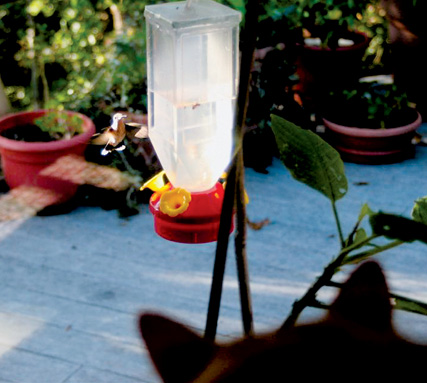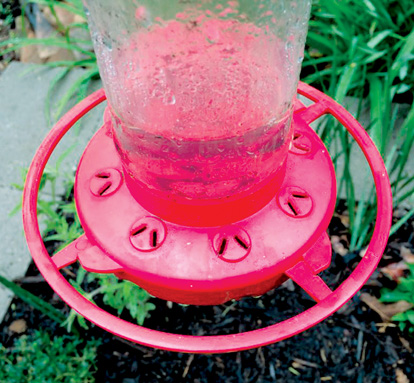Hummer Time

With all of the other spring signs several weeks early this year, I decided to put out my hummingbird feeders a few weeks early and turns out, I was just in time.
Hummingbirds winter over in Central and South America, migrating back north for our spring and summer while the southern hemisphere goes into its winter season. As they migrate north, the male hummingbirds are the first to show up at backyard feeders. They are the scouts, checking out food and nesting areas for the incoming females.
This year, I had one ruby-throated hummingbird at the feeder off my deck the first day I put out the feeder.
The story of how hummingbirds make this trip is amazing. During migration, a hummingbird’s heart beats up to 1,260 times a minute, and its wings flap 15 to 80 times a second.
They fly alone, often on the same path they have flown earlier in their life, and they fly low, just above tree tops or water. Flying low allows the birds to see, and stop at, food supplies along the way. They are also experts at using tail winds to help reach their destination faster. Research indicates a hummingbird can travel as much as 23 miles in one day.
You can help feed hummingbirds with a simple solution of sugar water. I make my sugar syrup one part sugar, four parts water. Mix the sugar in hot water out of the tap until the sugar dissolves completely. You don’t want to boil the water unless you boil, then let it cool off because boiled water can be too hot.
Once cooled, I store the sugar water in the refrigerator and only fill the hummingbird feeders halfway so the sugar water doesn’t spoil. Then change the sugar water every week or so; more often in warmer weather.
When cleaning out the hummingbird feeders, don’t use soap or any other cleaning agent or you may find the hummingbirds won’t use the hummingbird feeder. To keep mine clean, I rinse out with hot water and a give it a good scrubbing, then add a little dab of bleach in the water to remove any leftover mold and rinse well.
There was a nursery rhyme where I grew up in Brazil about hummingbirds getting rides on the backs of geese. I was at a conference of biologists many years ago listening to one present his theory of how those tiny birds make the long trek across the Gulf of Mexico. After basically saying they couldn’t prove beyond a shadow of a doubt how hummingbirds fly across that long expanse of water without food, I mentioned the nursery rhyme and asked if there was any possibility that those two species worked together.
The scientist said no, they knew the hummingbirds made it across the Gulf of Mexico because they found their little exhausted bodies along the shoreline.
The voice of an old gruffy, well-respected biologist came from the back. “That’s where the geese dump them.”
Charlotte Ekker Wiggins is a beekeeper, gardener and sometimes cook. Published by El Dorado Springs Sun once in print and online with author’s permission. Copyright 2017, all rights reserved. This column may not be reprinted, republished or otherwise distributed without author’s permission. Contact Charlotte at gardeningcharlotte at gmail dot com.

CAT SCAN – This is one of my inside cats supervising the hummingbird feeder out of the window to my deck. This cat in particular takes her supervisory duties very seriously and lets me know whenever there is a hummingbird at the feeder.

SLOT MACHINE – A good hummingbird feeder has feeding slots that are flush with the surface. That way the feeder can easily be cleaned with an old toothbrush and hot water. Do not use detergent when cleaning a hummingbird feeder, a little bleach in water will remove any mold growing inside the container. (Photos by Charlotte Ekker Wiggins).



Facebook Comments